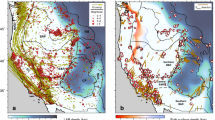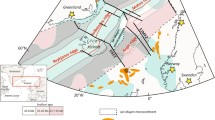Abstract
Based on the recent observations about the movement and rheological structure of the lithosphere and deformation pattern of the crust, we developed a three-dimensional finite element model for the northeastern margin of the Tibetan Plateau. The model considered the impacts of both external and internal conditions, including mantle convection, gravitational potential energy and block interactions. We compared the simulated surface movement rates to the observed GPS velocities, and the results revealed that crustal movement gradually decreased toward the edge of the plateau. The factors controlling this pattern are the interactions of adjacent blocks, gravitational potential energy of the plateau, and also mantle convection as well. Additionally, according to the observation that there was an apparent difference between the horizontal movement rate of the lithosphere and convective velocity of the underlying mantle, and also based on the results of seismic anisotropy studies that suggest different strengths and deformation regimes of the lithosphere in different tectonic blocks, we proposed that the impact of mantle convection on the lithosphere may have varied in space, and introduced a parameter named mantle convection intensity factor in numerical simulations. Our simulation results show consistent surface movement rates with GPS observations, which further supports the viewpoint of seismic anisotropy studies, i.e., the degree of coupling between the crust and mantle varies significantly among different blocks.
Similar content being viewed by others
References
ADINA R& D. Inc. June 2010. Theory and Modeling Guide Volume I: ADINA, Report ARD 10–7
Becker T W, Faccenna C. 2011. Mantle conveyor beneath the Tethyan collisional belt. Earth Planet Sci Lett, 310: 453–461
Bird P. 1999. Thin–plate and thin–shell finite–element programs for forward dynamic modeling of plate deformation and faulting. Comput Geosci, 25: 383–394
Bird P, Liu Z, Rucker W K. 2008. Stresses that drive the plates from below: Definitions, computational path, model optimization, and error analysis. J Geophys Res, 113: B11406
Bourne S J, England P C, Parsons B. 1998. The motion of crustal blocks driven by flow of the lower lithosphere and implications for slip rates of continental strike–slip faults. Nature, 391: 655–659
Chang L J, Ding Z F, Wang C Y, Flesch L M. 2017. Vertical coherence of deformation in lithosphere in the NE margin of the Tibetan plateau using GPS and shear–wave splitting data. Tectonophysics, 699: 93–101
Chen L, Capitanio F A, Liu L, Gerya T V. 2017. Crustal rheology controls on the Tibetan plateau formation during India–Asia convergence. Nat Commun, 8: 15992
Chen Y T, Yang Z X, Zhang Y, Liu C. 2013. From 2008 Wenchuan earthquake to 2013 Lushan earthquake (in Chinese). Sci China Earth Sci, 43: 1064–1072
Cui D X, Wang Q L, Hu Y X, Wang W P, Liang W F. 2009. Lithosphere deformation and deformation mechanism in northeastern margin of Qinghai–Tibet plateau (in Chinese). Chin J Geophys, 52: 1490–1499
Faccenna C, Becker T W, Conrad C P, Husson L. 2013. Mountain building and mantle dynamics. Tectonics, 32: 80–93
Fang Y, Jiang Z S, Zhang J, Wu Y Q. 2009. High–resolution characteristics of recent crustal movement in Qinghai–Tibet Plateau (in Chinese). Earth Sci—J China Univ Geosci, 34: 399–404
Flesch L M, Haines A J, Holt W E. 2001. Dynamics of the India–Eurasia collision zone. J Geophys Res, 106: 16435–16460
Flesch L M, Holt W E, Silver P G, Stephenson M, Wang C Y, Chan W W. 2005. Constraining the extent of crust–mantle coupling in central Asia using GPS, geologic, and shear wave splitting data. Earth Planet Sci Lett, 238: 248–268
Fu R S, Huang J H, Xu Y M, Chang X H. 1998. Study of the mantle dynamics of the lithosphere movements in the region from Qinghai–Xizang plateau to Tianshan mountain (in Chinese). Chin J Geophys, 41: 658–668
Fu R S, Huang J H, Dong S Q, Zhang Q S, Chang X H. 2003. A new mantle convection model constrained by seismic tomography data (in Chinese). Chin J Geophys, 46: 772–778
Fu R S, Wang J Y, Chang X H, Huang J H, Dai Z Y, Zha X J. 2005. Upper mantle convection driving by density anomaly and a test model (in Chinese). Acta Seismol Sin, 27: 25–32
Ge W P, Wang M, Shen Z K, Yuan D Y, Zhen W J. 2013. Intersiesmic kinematics and deformation patterns on the upper crust of Qaidam–Qilianshan block (in Chinese). Chin J Geophys, 56: 2994–3010
Hao M, Qin S L, Li Y H, Chang X H. 2014. Recent horizontal velocity field of north eastern Tibetan plateau (in Chinese). J Geod Geody, 34: 99–103
He J K, Lu S J, Wang W M. 2013. Three–dimensional mechanical modeling of the GPS velocity field around the northeastern Tibetan plateau and surrounding regions. Tectonophysics, 584: 257–266
Heidbach O, Tingay M, Barth A, Reinecker J, Kurfeß D, Müller B. 2010. Global crustal stress pattern based on the World Stress Map database release 2008. Tectonophysics, 482: 3–15
Huang J, Zhong S. 2005. Sublithospheric small–scale convection and its implications for the residual topography at old ocean basins and the plate model. J Geophys Res, 110: B05404
Huang J P, Fu R S, Zheng Y, Xue T X, Liu X, Han L B. 2008. The influence of mantle convection on the lithospheric deformation of China mainland. Chin J Geophys, 51: 733–743
Li Q, You X Z, Yang S M, Du R L, Qiao X J, Zou R, Wang Q. 2012. A precise velocity field of tectonic deformation in China as inferred from intensive GPS observations. Sci China Earth Sci, 55: 695–698
Li Y H, Cui D X, Hao M. 2015. GPS–constrained inversion of slip rate on major active faults in the northeastern margin of Tibet Plateau (in Chinese). Earth Sci—J China Univ Geosci, 40: 1767–1780
Li Y H, Wu Q J, Pan J T, Zhang F X, Yu D X. 2013. An upper–mantle Swave velocity model for East Asia from Rayleigh wave tomography. Earth Planet Sci Lett, 377–378: 367–377
Li Z N, Fu R S, Huang J H. 2002. Numerical simulation of the Qinghai–Xizang plateau uplift under the effect of denudation and mantle convection (in Chinese). Chin J Geophys, 45: 516–524
Liang S M, Gan W J, Shen C Z, Xiao G R, Liu J, Chen W T, Ding X G, Zhou D M. 2013. Three–dimensional velocity field of present–day crustal motion of the Tibetan Plateau derived from GPS measurements. J Geophys Res–Solid Earth, 118: 5722–5732
Liu M, Yang Y Q. 2003. Extensional collapse of the Tibetan Plateau: Results of three–dimensional finite element modeling. J Geophys Res, 108: 2361
Shi Y L, Cao J L. 2008. Effective viscosity of China continental lithosphere (in Chinese). Earth Sci Front, 15: 82–95
Steinberger B, Schmeling H, Marquart G. 2001. Large–scale lithospheric stress field and topography induced by global mantle circulation. Earth Planet Sci Lett, 186: 75–91
Stolk W, Kaban M, Beekman F, Tesauro M, Mooney W D, Cloetingh S. 2013. High resolution regional crustal models from irregularly distributed data: Application to Asia and adjacent areas. Tectonophysics, 602: 55–68
Sun Y J, Deng S W, Fan T Y, Zhang H, Shi Y L. 2013. 3D rheological structure of the continental lithosphere beneath China and adjacent regions (in Chinese). Chin J Geophys, 56: 2936–2946
Teng J W, Bai D H, Yang H, Zhang H S, Zhang Y Q, Yan Y F, Ruan X M. 2008. Deep processes and dynamic responses associated with the Wenchuan MS8.0 earthquake of 2008 (in Chinese). Chin J Geophys, 51: 1385–1402
Wang X C, Li Y H, Ding Z F, Zhu L P, Wang C Y, Bao X W, Wu Y. 2017. Three–dimensional lithospheric S wave velocity model of the NE Tibetan Plateau and western North China Craton. J Geophys Res–Solid Earth, 122: 6703–6720
Wang X F, He J K. 2012. Channel flow of the lower crust and its relation to large–scale tectonic geomorphology of the eastern Tibetan Plateau. Sci China Earth Sci, 55: 1383–1390
Xiong X, Teng J W. 2002. Study on crustal movement and deep process in eastern Qinghai–Xizang Plateau (in Chinese). Chin J Geophys, 45: 507–515
Xiong X, Fu R S, Teng J W, Xu H Z. 2005. A study of mantle dynamics of the tibetan plateau (in Chinese). Adv Earth Sci, 20: 970–979
Xiong X, Shan B, Wang J Y, Zheng Y. 2010. Small–scale upper mantle convection beneath the Mongolia–Baikal rift zone and its geodynamic significance. Chin J Geophys, 53: 529–541
Xu T, Wu Z B, Zhang Z J, Tian X B, Deng Y F, Wu C J, Teng J W. 2014. Crustal structure across the Kunlun fault from passive source seismic profiling in East Tibet. Tectonophysics, 627: 98–107
Xu Z Q, Yang J S, Li H B, Zhang J X, Zeng L S, Jiang M. 2006. The Qinghai–Tibet plateau and continental dynamics: A review on terrain tectonics, collisional orogenesis, and processes and mechanisms for the rise of the plateau (in Chinese). Geol China, 33: 221–238
Yuan D Y, Zhang P Z, Liu B C, Mao F Y, Gan W J, Wang Z C, Zheng W J, Guo H. 2004. Geometrical imagery and tectonic transformation of late quaternary active tectonics in northeastern margin of Qinghai–Xizang Plateau (in Chinese). Acta Geol Sin, 78: 270–278
Yin X C. 1985. Solid Mechanics (in Chinese). Beijing: Seismological Press
Zhang D N, Yuan S Y, Shen Z K. 2007. Numerical simulation of the recent crust movement and the fault activities in Tibetan Plateau (in Chinese). Chin J Geophys, 50:153–162
Zhang P Z, Deng Q D, Zhang G M, Ma, Gan W J, Min W, Mao F Y, Wang Q. 2003. Active tectonic blocks and strong earthquakes I the continent China. Sci China Ser D–Earth Sci, 46 (Suppl):13–24
Zhang P Z, Deng Q D, Zhang Z Q, Li H B. 2013. Active faults, earthquake hazards and associated geodynamic processes in continental China (in Chinese). Sci China Earth Sci, 43: 1607–1620
Zheng W J, Zhang P Z, Yuan D Y, Zheng D W. 2009. Deformation on the northern of the Tibetan plateau from GPS measurement and geologic rates of Late Quaternary along the major fault (in Chinese). Chin J Geophys, 52: 2491–2508
Zheng Y, Fu R S, Xiong X. 2006. Dynamic simulation of lithospheric evolution from the modern China mainland and its surrounding areas (in Chinese). Chin J Geophys, 49: 415–427
Zhu A Y, Zhang D N, Jiang C S. 2016. Numerical simulation of the segmentation of the stress state of the Anninghe–Zemuhe–Xiaojiang faults. Sci China Earth Sci, 59: 384–396
Zhu T. 2014. Tomography–based mantle flow beneath Mongolia–Baikal area. Phys Earth Planet Inter, 237: 40–50
Zhu T. 2016. Lithospheric stress and uppermantle dynamics in mainland China due to mantle flow based on combination of global–and regionalscale seismic tomography. J Asian Earth Sci, 132: 103–117
Zhu T. 2017. Effects of Eurasian plate motions on mantle convective velocity and horizontal shear stress fields at the base of the lithosphere beneath Mainland China (in Chinese). Geosci Front, 24: 192–206
Acknowledgements
We thank Professors Xiong Xiong, Yuan Daoyang, Tang Fangtou, and Chang Lijun, three anonymous reviewers, and the chief editor for their useful suggestions. We used Moho depths data calculated by Dr. Wang Xingchen and Prof. Ding Zhifeng, the crustal structure data of Stolk (2013), and the P and S wave velocity data of Li Yonghua (2013). We express our sincere thanks to the providers of these data. This study was supported by the National Natural Science Foundation of China (Grant No. 41504079), and the China National Special Fund for Earthquake Scientific Research in Public Interest (Grant No. 201308011).
Author information
Authors and Affiliations
Corresponding author
Rights and permissions
About this article
Cite this article
Zhu, A., Zhang, D., Zhu, T. et al. Influence of mantle convection to the crustal movement pattern in the northeastern margin of the Tibetan Plateau based on numerical simulation. Sci. China Earth Sci. 61, 1644–1658 (2018). https://doi.org/10.1007/s11430-017-9236-7
Received:
Revised:
Accepted:
Published:
Issue Date:
DOI: https://doi.org/10.1007/s11430-017-9236-7




